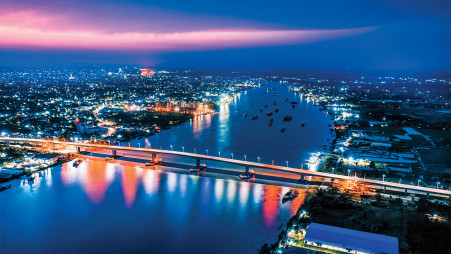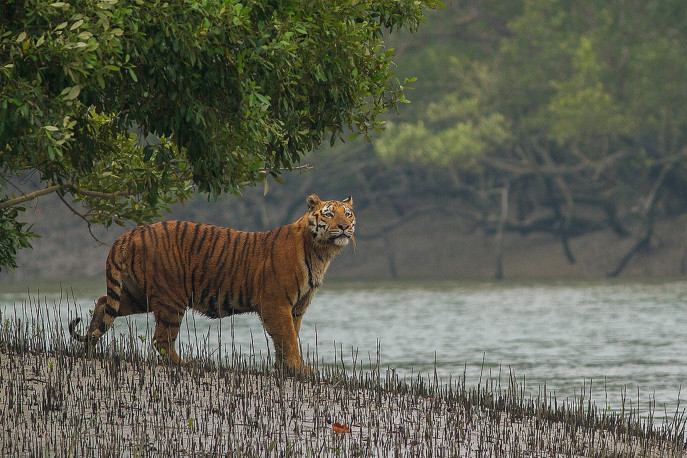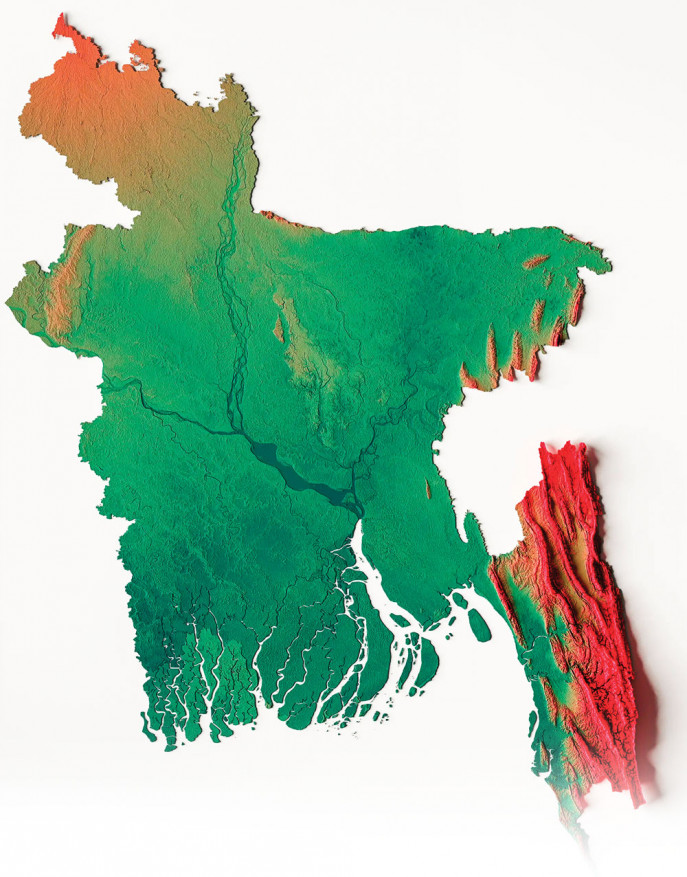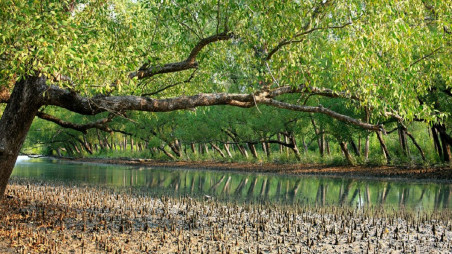The Padma Bridge will be opened very soon which will definitely increase economic activities in this region
TBS Report
28 January, 2022, 03:30 pm
Last modified: 28 January, 2022, 03:32 pm
PHOTO: MD REPON BHUIYAN
“> 
PHOTO: MD REPON BHUIYAN
Khulna division has not seen that much economic progress despite having all the geographic diversities and natural resources, including the Sundarbans. Unplanned development projects have caused a lot of environmental damage to the region over the last 50-years.
Experts suggest that safe extraction of Sundarbans natural resources, connection of Mongla port with Nepal, Bhutan, revival of newsprint and jute-mills, extension of an expressway between Bhanga and Mongla and a gas link in the region could pave way for industrialisation of Khulna.
The Business Standard organized a webinar called “Industrialization of Khulna: Problems & Opportunities”. The webinar stressed that all development plans must be considered while respecting environmental rules and protecting the Sundarbans.
Inam Ahmed, editor, The Business Standard
The Khulna region has two special features the Mongla seaport and Benapole. However, the much-debated connectivity of Mongla port to Nepal and Bhutan has yet to be implemented. The Khulna Jashore road’s condition is poor. The construction of Khulna’s airport has been stalled. Jashore Airport, however, is the only airport in the region. Only one EPZ is located in the region, while two specialised economic zones are expected to be built.
The area used to produce a lot frozen products. But, it seems that this is decreasing. There is no gas connection in the area. Sundarbans, an ecosystem unique to this region, is at risk because of the development of many industries in the area. The water is also becoming more salinized.
Today we will discuss if this region can be livable despite the effects of industrialisation and urbanisation.
Many forest rangers have seen tigers in the Sundarbans since the shutdown. Photo: Collected
“> 
Since the shutdown, many forest rangers have spotted tigers at the Sundarbans. Photo: Collected
Sheikh Humayun Kabir, vice-president, Bangladesh Frozen Foods Exporters Association
Khulna was once a subdivision of Jashore, then it became a district and later a division. The region has all the resources necessary for economic development. Khulna is one of the two rivers ports of Bangladesh, but we have not been in a position to take advantage of this port since independence. We also failed in our efforts to sustain the newsprint industry, jute mills and hardboard/textile mills, etc. Khulna’s economic prospects were raised later when frozen shrimp was exported.
However, this too has been in decline because of a lackluster demand for shrimp on the international market. Vannamei shrimp from Hawaii has overtaken our shrimp and lobster markets. Bangladesh is now 8th in shrimp exports.
Vannamei shrimps are much more productive than local varieties. For example, while we can produce 350kg of shrimps and lobsters from one acre of land in our local varieties, the Vannamei production rate is many times higher. We are interested now in cultivating Vannamei Shrimps in the coastal regions of Khulna.
Khulna was once an industrial city. It still has a low labour rate, which will make it a great place to set up factories. It is time for us to restart the factories that have been closed. The government could acquire large amounts of land here that has been abandoned to be used for economic activities.
The Padma Bridge will soon be open, which will increase economic activity in the region. All Khulna residents should think about this.
It is important to renovate the roads in Khulna and build new infrastructures. Now is the time to start thinking about how we can export the Khulna products. It will be possible for Khulna to be transformed in the next 50-years if the Export Processing Bureau, Khulna Chamber of Commerce, and other concerned people work harder.
Md Ali Akbar Tipu, panel mayor, Khulna City Corporation
All the people concerned, including journalists and civil society members, irrespective of political affiliation must come forward to implement the Prime Minister’s Vision 2041 plan. We must work together for education and health as well as cultural development. About 120 state leaders attended the COP 26 conference in Glasgow, UK, to discuss climate change. I was also able to attend.
Khulna is a region that I consider to be the most vulnerable to climate change. There are fears of natural disasters like tornadoes, cyclones, and tidal waves. After returning from Glasgow, I have already organized a meeting in Khulna on climate change. We didn’t get much benefit from the COP-26 conference, and we want the implementations made to address climate problems. Economic protection must be provided for all 42 countries, including Bangladesh.
We need to pay attention and we all have the responsibility of raising a common voice. Journalists must speak up the most. We must work together, we need to move, and we must inform the prime minister who spoke at COP-26 for the 42 countries that called for economic protection.
However, there have been some positive decisions made at the climate conference this year. For example, bringing down air pollution to zero. Our government also pledged to not build any coal-powered power plants. Many countries around the globe are turning to electric vehicles to reduce their pollution.
Sundarbans is being demolished, which is a concern from the perspective climate change. Environment pollution is a result of Khulna’s inept waste management systems.
Illustration: TBS
“> 
Illustration: TBS
Md Mofidul Islam Tutul, director, Khulna Chamber of Commerce and Industry
Khulna is the third largest city in Bangladesh, which has a lot of economic potential with Mongla port, Benapole and Bhomra land ports. The development of Khulna had been stalled in the past. However, the current government is building the Padma Bridge to help Khulna develop. The government could connect Nepal and Bhutan to the Mongla port, transforming it into an industrial city. This will increase the region’s geo-economic importance. Although Khulna has a huge potential for industrialization, there are also many problems.
Otherwise, traffic jams would occur after the Padma Bridge’s inauguration. The road to Mongla does not have enough width. We can only use 40% of the port’s total capacity. This port will be even more efficient if it is extended. We also need gas connections in Khulna for industrialisation.
Already, we are seeing people selling a lot of land around Mongla and Bhanga for industrial purposes. The area has seen land prices rise. We hope that the area will become an industrial zone. The Department of Environment and other concerned authorities must be informed so that industrialisation in the area is done in a planned manner.
The News Print Mills, Hardboard Mills and Jute Mills in Khulna are all close to being closed. These industries must be revived using modern technology.
The Sundarbans are the region’s greatest resource. This is why we need to build a tourist center. It is a long-standing request from our government.
Construction of the Khan Jahan Ali Airport is a must. Foreign passengers will be able to travel to Khulna if the Padma Bridge opens.
The government has already promised that the Khulna–Jessore, and Khulna–Mongla six-lane expressways will be constructed. Noapara bypass roads will also be built. This would help to save a lot time.
Two EPZs have been proposed by the government in Rupsha, Batiaghata, and Khulna. A modern hospital in Khulna is also needed to ensure that Khulna residents don’t have to travel to Dhaka to receive better care.
Shamima Sultana Shilu, woman entrepreneur
The economic potential of Khulna has faded. There is still hope. Khulna offers many opportunities to women entrepreneurs. They can use the waste materials from different products, such as rice, jute or fishes, and they can also make furniture using betel nuts. They can make buttons from coconut shells, plates, and furniture made from betel nuts shells. Women in Khulna can become economically self-sufficient with the support of the government. They only need to receive proper training in this area.
Gouranga Nandy, journalist and environment activist
Khulna lacks mills and factories as there is no gas connection in Khulna except for the power plants. The government has set up a few educational institutions in the region. The Mongla port is still not being fully utilized. The jute industry hasn’t been developed to produce diverse products.
This area is dominated by the Gangetic lowlands, which are considered an immature Delta. We have done some development work before the land matured. This includes the construction water dams in the 60s, which caused waterlogging in some parts. Many lands, including the Bhabadaha Beel, have been abandoned because of waterlogging. This is an example of unplanned growth.
Studies have shown the region is more affected by unplanned developments than climate change. Many people have lost their homes and had to relocate because of unplanned developments. We must consider the Sundarbans as well as climate change when planning for the development of the area.
Shaikh Ashrafuzzaman, secretary-general, Greater Khulna Development Action Coordination Committee
There are many rivers in Khulna region which are almost dead now. Kopotakkho and Bhadra rivers are just two examples. Most rivers don’t have enough drinking water. Navigation at Mongla port will be halted if there is an accident on the bridge that crosses Rupsha river.
Other than the Khulna University and Khulna University of Engineering and Technology, there are no other institutes within the region that can conduct research. We don’t have any good hospitals, places to breathe fresh air, or a recreation center in the city.
Both banks of Mongla have been illegally occupied, and the younger generation is turning towards drugs. These issues should be addressed in Khulna.
Small tourist centers could be established on both sides of river from Jalna and Fultala areas to protect Khulna’s younger generation from drugs. These areas are known for being drug-dealing hotspots.
The Mongla port’s capacity should be increased, as it has the potential to become a port similar to Chattogram port.
Even though an airport was planned for Khulna in 1963, it is still not there. The government should develop short- and long-term plans to develop this region.
Tamanna Tabassum Shova, women entrepreneur
We need training for women entrepreneurs in Khulna to develop their skills. There are many abandoned lands in Khulna that could be used to create small, cottage industries for women’s economic growth. These could include low-cost products.
The authorities promised to set up a weekly market where women could sell their products. The government’s attention could help the small and cottage industries of Khulna realize their potential.
Professor Dr Abdullah Harun Chowdhury, dean of environmental science, Khulna University
We started the first environmental science department in Bangladesh 25 years ago at Khulna University with emphasis on environment and climate.
The region is rich with natural resources, including the Sundarbans, which are the only mangrove forests in the world. It has enormous potential for economic and industrial development.
Citizens from all walks must also be encouraged to take advantage of the potential.
Climate change is a major problem in the world, including Bangladesh. This problem must be addressed.
As an environmentalist I was able to participate in the Khulna Development Authority’s masterplan implementation projects. This included areas like Fakirhat Union, Rampal, and Mongla.
The masterplan clearly states that all development work should be done on the land, excluding permanent reservoirs that comply with environmental rules. Some people are filling the low water bodies and canals surrounding the city with water and selling it, resulting in a shortage of fresh water in and around Khulna.
Sundarbans, a file photo. photo: Collected
“> 
A file photo of Sundarbans. photo: Collected
Previously, water was available in tubewells 850 feet to 900 feet below the ground level, which has dropped to below 1,300 feet.
The city’s ponds can be used for garbage disposal. These ponds could hold rainwater, allowing bathing and other activities to be possible throughout the year. The ponds could also lower the temperature in the city.
The Khulna region requires long-term industrialization in an environmentally-friendly manner. Factories should have a modern waste management system. This should be made known to all residents in the area. It would be easier for the government to take action if they had active participation.
The Department of Environment must inspect the condition of factories before approving new industries.
For development projects in the region, coordination is necessary between all ministries and government departments.
Last but not least, I want to mention that the Sundarbans are like our mother. She saves us all from natural disasters. Without the Sundarbans, this region would not be able to survive. It is also a major source of natural resources.
No matter what political affiliation we may have, we must work together for the development Khulna.


